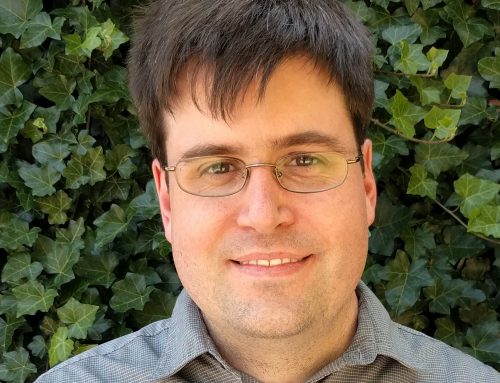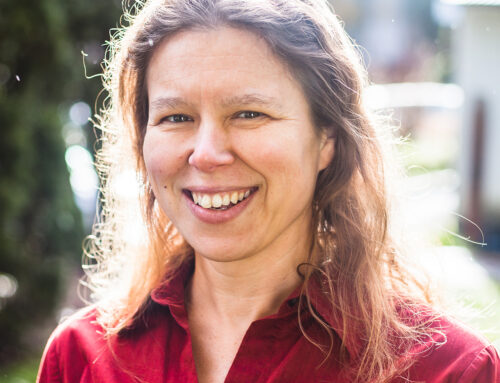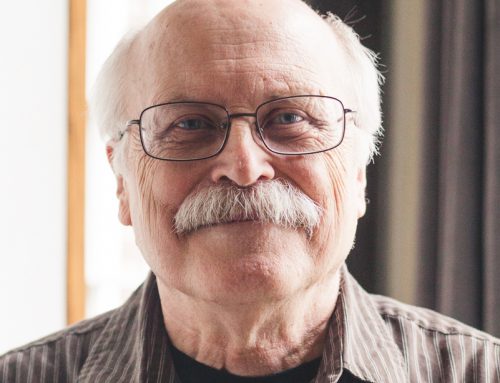Shakespeare’s characters often speculate that life has no meaning. Hamlet ponders suicide. Iago destroys Othello for no particular reason. And Macbeth accuses life of being
a tale
Told by an idiot, full of sound and fury,
Signifying nothing.
Contemporary critics and producers highlight this note of meaninglessness.[ref]Hamlet is often cast as a sort of postmodern adolescent wandering through a meaningless landscape. Ethan Hawke’s 2000 production situates Hamlet’s “To be nor not to be” speech under the plastic fluorescence of a Blockbuster video store.[/ref] They believe that it demonstrates Shakespeare was one of us. He foreshadowed our time, they say, a time when religious symbols and significance have been drained from our culture.
Our culture might resonate with this desolate theme, but Shakespeare’s audiences probably didn’t feel it as deeply. Fixtures on the Elizabethan stage demonstrated that England believed in a meaningful, ordered universe. These fixtures included a gorgeous painted canopy representing the order of the heavenly bodies. Beneath Hamlet’s feet lay a trap door that led to the cellarage, or hell. And the decorative area behind Hamlet was constructed to symbolize a castle, throne, city gate, and an altar. This intertwined social space would “remind audiences of unchanging social and religious order which their theatre was built to affirm” (Alvin Kernan, Introduction, Classics of the Modern Theatre, 1965).
Hamlet’s hopelessness was bracketed by symbols and physical fixtures that spoke to a Christian belief in a just afterlife. Yes, Shakespeare’s England was being yanked between the Protestants and Catholics. Even still, all England retained a deep conviction about the ultimate order of reality.
Fixtures State Assumptions
Every age surrounds and populates its theatre stages with physical fixtures that reveal beliefs. From Greece to Rome to Elizabethan England, symbols and fixtures state assumptions. This essay explores briefly the theatre stages of earlier eras before asking what our stage tells us about ours.
The Greek chorus was the first theatrical fixture in the Western world. Greek tragedies were not acted by individuals but were chanted by choruses. According to legend, the first “play” began when one member stepped forward and began dialoguing back to the chorus. (This actor’s name was Thespis, from which we derive our word “thespian.”) With this development, our model of Western theatre was born.
The chorus reveals shared Greek assumptions about wisdom, honor, and justice. In Oedipus Rex, the chorus consists of wise elders. In Antigone, the chorus plays the role of conservative tradition. Although the purpose of the chorus would shift slightly from play to play, it consistently spoke on behalf of Greece.
Greek costumes revealed their notion of heroism. Their costumes made actors look larger than life. The actors who played Orestes, Oedipus, and Menelaus wore larger masks, helmets, and shoulder pads. This portrayed them as giant men who could endure the chaos that rained down from the gods. These larger-than-life heroes acted, suffered, and fought until the mysteries were solved.
If England’s stages revealed assumptions about the afterlife and Greece stages portrayed belief in heroic men, then what do our stages say about us?
Our Bare Stage
Our theatres reveal much through absence. Modern theatre spaces convey virtually no symbols, no physical fixtures, and no consistent theatrical devices. Before being dressed for a play, our theatres consist of bare, black walls and aluminum rigging for lighting.
Compare us with medieval theatre. After being banned for centuries, medieval plays were reestablished within churches. Virtually every square inch of a medieval church, whether Saxon or Gothic, was packed with symbols that functioned as a visual language. For example, medieval church paintings identified Saint Peter by placing kingdom-keys in his hand. Paintings and sculptures identified Saint Paul by giving him a sword representing biblical truth. Jonah was identified with a fish or whale. The Virgin Mary wore a lily to represent chastity.
Medieval churches brimmed with religious and cultural meaning. Our theatres demonstrate a lack of it. Many older theatre critics observed this difference. George Kernodle, author of “The Open Stage: Elizabethan or Existential?”, observed that the stage used to be “a symbol of social order and of divine order—of the real ties between man and king, between heaven and earth.” Francis Fergusson argued in The Idea of a Theater (1949) that our era has no true theatre because true theatre focuses “at the center of the life of the community the complimentary insights of the whole culture.” Having no “built-in symbols,” says Kernan, the modern stage is but a “small illuminated island lost in the vastness of space” (Modern Theater).
Our stage reveals that our culture has little in the way of shared cultural assumptions. The United States began with a deep affinity for Protestant Christianity. And while Barna surveys occasionally reveal continued belief in God, there is a growing understanding that we now live in a secular age. The theologian James K. A. Smith likened the change to the closing of the Toronto Sky Dome during a game. We used to acknowledge the heavens. Now an iron dome has closed over us, and we just watch the players.
Some contemporary playwrights kick against today’s secularity. Sarah Ruhl writes quasi-spiritual stage directions into her plays. For example, in Eurydice, a young woman descends into hell through a metaphysical elevator. There she meets her father, a devil, and a chorus of speaking stones.
Although I am not terribly fond of Ruhl’s plays, I respect her instinct. Anything to flash glimmers of transcendence to the metaphysically bored.
But Ruhl’s plays are uncommon in their attempt to bridge into another world. Modern playwrights do not search for meaning through high purpose but by examining personal relationships—especially family relationships.
Modern playwrights are obsessed with family dynamics. The family is one of the few pockets of dramatic meaning in contemporary life, and it has provided the source material for the best remembered American dramas of the last century. Our Town (1938), Streetcar Named Desire (1947), Death of a Salesman (1949), Long Day’s Journey Into Night (1956), and Who’s Afraid of Virginia Woolf (1966) are all family plays. Moreover, half of the Pulitzer winners for drama in the last twenty years focus on family dynamics, dysfunction, and disintegration. Aeschylus and Shakespeare fixated on kings, queens, and warriors. We are fixated on our families.
Eternity Is Privatized
“God has set eternity in the hearts of men,” said the Preacher in Ecclesiastes. The impulse to find God has not disappeared (indeed, will not disappear) from our consciousness. But the impulse has been privatized. Unlike Shakespeare’s time, transcendent meaning is today confined to the individual and pockets of believers.
In her book Living By Fiction, author Annie Dillard observes that meaning evaporates when a culture ceases to share values:
If meaning is contextual, and it is, then the collapse of ordered Western society and its inherited values following World War I cannot be overstressed; when we lost our context, we lost our meaning. We became, all of us in the West, more impoverished and in one sense more ignorant than pygmies, who, like the hedgehog, know one great thing: in this case, why they are here.
The middle of the twentieth century seemed to have caught up to the poet Matthew Arnold’s insight in the late nineteenth century: We were now between two worlds—“The Sea of Faith” and “Its melancholy, long, withdrawing roar” (“Dover Beach,” 1867). Playwrights, novelists, and artists after World War I began to observe the change. They wrote characters who, like Shakespeare’s characters, lurched between faith and despair. Graham Greene’s “whiskey priest” in the novel The Power and the Glory (1940) does his religious duty while suffering terrible doubt. Flannery O’Connor’s characters are haunted alternately by Jesus Christ and then the anti-Christ. Walker Percy’s protagonists believe in God one moment and then lurch toward harsh materialism the next.
Each of these artists struggled to reconcile their earnest desire for faith with the harsh landscape of the modern world. Paul Elie wrote a biography of four prominent Catholics (O’Connor, Percy, Thomas Merton, Dorothy Day) who wrote during the middle of the twentieth century. His book, The Life You Save May Be Your Own: An American Pilgrimage (2003), encapsulates their struggle of faith in a secular age. Elie writes,
We are all skeptics now, believer and unbeliever alike. There is no one true faith, evident at all times and places. Every religion is one among many. The clear lines of any orthodoxy are made crooked by our experience, are complicated by our lives. Believer and unbeliever are in the same predicament, thrown back onto themselves in complex circumstances, looking for a sign. As ever, religious belief makes its claim somewhere between revelation and projection, between holiness and human frailty; but the burden of proof, indeed the burden of belief, for so long upheld by society, is now back on the believer, where it belongs.
The story of how we arrived here is long and winding. To retrace the history is not the purpose of this essay.[ref]One of the best interpretations I know is Charles Taylor’s The Secular Age (2007). If you don’t have the time for such a massive (900 page) book, try the more manageable How to Not Be Secular (150 pages) by James K. A. Smith.[/ref] This essay hopes to convince you that it has arrived.
As a younger man living in the South, I objected to the idea that we lived after Christendom. It was difficult for me to see off my island. I was surrounded by a church community where Christian theism was not only believable but a default certainty. But spending time in Europe, in Oregon, in Washington D.C. showed me how different my convictions were from most.
Last week, I spoke with an American named Steve who pastors a small church in Barcelona. Since moving to Spain, Steve has become convinced of the power of cultural “metanarratives.” “I heard this idea in seminary,” he said. “And having lived in Barcelona, I’ve become even more convinced it’s true. Every culture has assumptions that define their unspoken attitudes. In Martin Luther’s time, people were concerned with hell and heaven. That’s not on Spain’s radar anymore.”
It is no surprise that Barcelona is a permissive society. “Porn capital of Europe,” he said. But it is also a deeply moral and compassionate society. “We live in a town that’s very civil. The Spanish are very compassionate people. If any relief-cause need comes up, the Spanish will give a lot of money.”
Absent a default belief in the supernatural, Spanish people search for meaning in the same places as do contemporary playwrights: in relationships. “We’re not particularly seeing people come to faith through our crafty recasting of the gospel,” Steve said. “I try to teach the gospel every Sunday. And it helps having our people hear these things. But the way people are being converted is by the bottom of their lives falling out. Broken marriages, broken families, losing a job. They come to us when their friends—their Christian friends—are there when it happens and genuinely love them.”
A keen faith, of course, is not founded upon the shifting winds of culture. But neither does it shrink from a frank appraisal of culture. The Christianity I come from, evangelicalism, today seems content to simply resent our world. We seem more interested in complaining about problems than in proposing alternatives. This is disheartening.
Instead of retreating into frustration, I would rather belong to the missionaries, teachers, artists, entrepreneurs, and ditch-diggers who neither resent nor obey our time—who want to find and forge a life of transcendence in this secular era.






